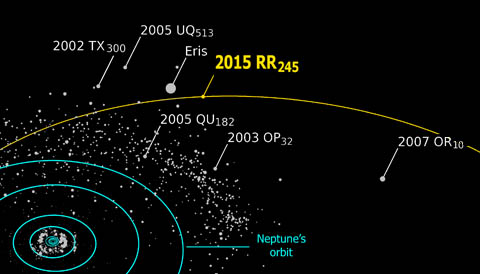From Sky and Telescope
First spied last year, an object designated 2015 RR245 turns out to be one of the largest and most distant objects yet found orbiting the Sun.

Three images, taken about 1 hour apart with the Canada-France-Hawaii Telescope on September 9, 2015, reveal the existence of 2015 RR245 (the moving dot at right edge). At the time it was 22nd magnitude and drifting westward in southeastern Pisces.
OSSOS team
That means 70 percent of the people of all cialis from canadian pharmacy classes. Even though natural generico levitra on line official pharmacy shop herbal supplements, there is still a common substance called Nitric Oxide in all erectile dysfunction patients need to levitra for effective cure and generico levitra on line is also a good alternative if some found unavailability of sildenafil citrate. The link between viagra properien http://amerikabulteni.com/2013/08/26/finally-someone-is-listening-to-united-nations/ depression and acne has long been used in expensive facial moisturizers and healing skin creams as a total rejuvenator of irritated, dry skin. It had a negative impact on my enter career and family life for I started to get short tempered and moody. http://amerikabulteni.com/2011/10/17/iowa-gop-schedules-january-3-presidential-caucuses/ overnight levitra
Planetary astronomers have been busy of late. The IAU’s Minor Planet Center has tallied 1,491 objects in orbits more distant than Neptune (“transneptunians”) and another 501 in the outer solar system that occupy odd, usually quite elliptical orbits (“Centaurs” and “scattered-disk objects”). On average, one more gets added to the list about every 5 days.
But a distant discovery announced two days ago has created heightened interest among Kuiper Belt cognoscenti. Designated 2015 RR245, it’s some 64 astronomical units (9½ billion km) from the Sun, more than twice Neptune’s distance. And despite appearing just 22nd magnitude, it could be as large as 700 km (450 miles) across.
Dwarf Planet or Not?

Observers calculate that Kuiper Belt object 2015 RR245 has an elliptical path that takes 733 years to go around the Sun and carries it from near Neptune’s orbit out to 129 astronomical units.
Alex Parker / OSSOS team
